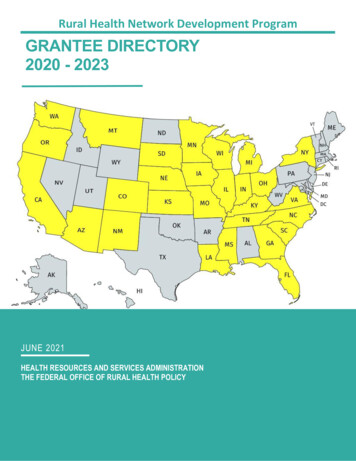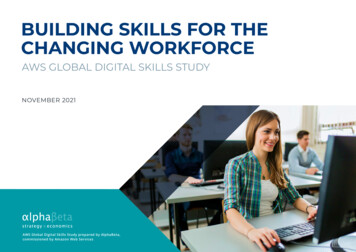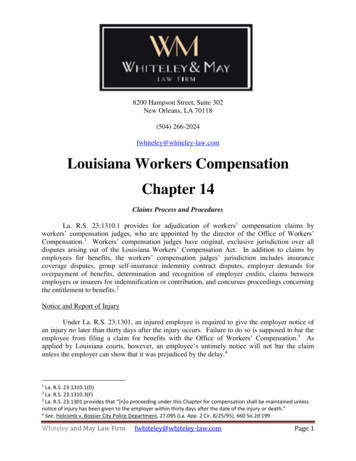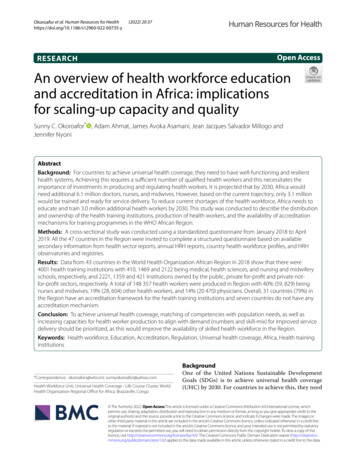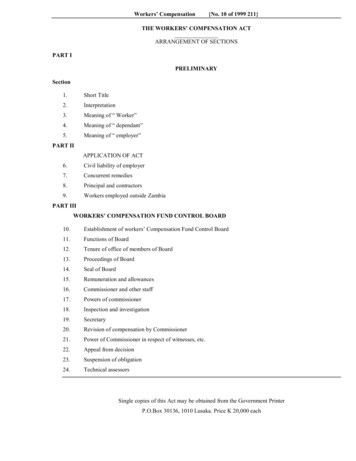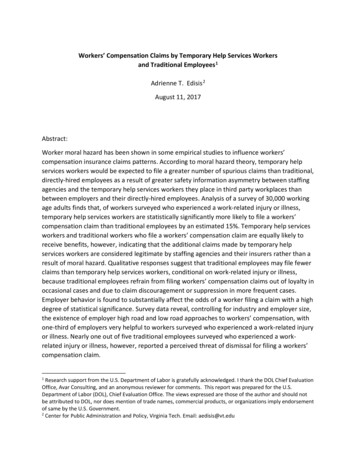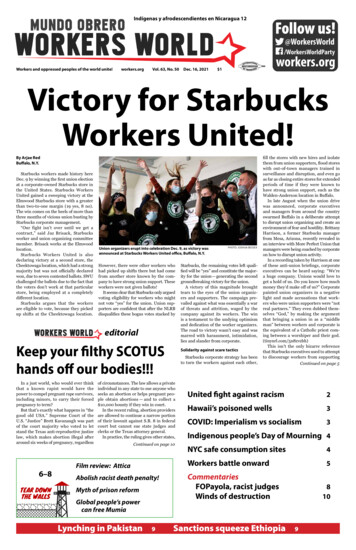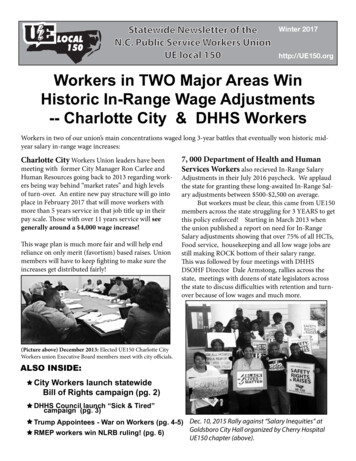
Transcription
HEALTH WORKERS’ EDUCATIONAND TRAINING ON ANTIMICROBIALRESISTANCECURRICULA GUIDE
HEALTH WORKERS’ EDUCATIONAND TRAINING ON ANTIMICROBIALRESISTANCE:CURRICULA GUIDE
Health workers’ education and training on antimicrobial resistance: curricula guideISBN 978-92-4-151635-8 World Health Organization 2019Some rights reserved. This work is available under the Creative Commons Attribution-NonCommercial-ShareAlike 3.0 IGO licence(CC BY-NC-SA 3.0 IGO; igo).Under the terms of this licence, you may copy, redistribute and adapt the work for non-commercial purposes, provided the workis appropriately cited, as indicated below. In any use of this work, there should be no suggestion that WHO endorses any specificorganization, products or services. The use of the WHO logo is not permitted. If you adapt the work, then you must licenseyour work under the same or equivalent Creative Commons licence. If you create a translation of this work, you should addthe following disclaimer along with the suggested citation: “This translation was not created by the World Health Organization(WHO). WHO is not responsible for the content or accuracy of this translation. The original English edition shall be the bindingand authentic edition”.Any mediation relating to disputes arising under the licence shall be conducted in accordance with the mediation rules of theWorld Intellectual Property Organization.Suggested citation. Health workers’ education and training on antimicrobial resistance: curricula guide. Geneva: World HealthOrganization; 2019. Licence: CC BY-NC-SA 3.0 IGO.Cataloguing-in-Publication (CIP) data. CIP data are available at http://apps.who.int/iris.Sales, rights and licensing. To purchase WHO publications, see http://apps.who.int/bookorders. To submit requests forcommercial use and queries on rights and licensing, see http://www.who.int/about/licensing.Third-party materials. If you wish to reuse material from this work that is attributed to a third party, such as tables, figures orimages, it is your responsibility to determine whether permission is needed for that reuse and to obtain permission from thecopyright holder. The risk of claims resulting from infringement of any third-party-owned component in the work rests solelywith the user.General disclaimers. The designations employed and the presentation of the material in this publication do not imply theexpression of any opinion whatsoever on the part of WHO concerning the legal status of any country, territory, city or areaor of its authorities, or concerning the delimitation of its frontiers or boundaries. Dotted and dashed lines on maps representapproximate border lines for which there may not yet be full agreement.The mention of specific companies or of certain manufacturers’ products does not imply that they are endorsed orrecommended by WHO in preference to others of a similar nature that are not mentioned. Errors and omissions excepted, thenames of proprietary products are distinguished by initial capital letters.All reasonable precautions have been taken by WHO to verify the information contained in this publication. However, thepublished material is being distributed without warranty of any kind, either expressed or implied. The responsibility for theinterpretation and use of the material lies with the reader. In no event shall WHO be liable for damages arising from its use.Printed in Switzerland.
iExecutive summaryviii1. Introduction11.1 Rationale21.2 Curricula delivery61.3 Assessing learners81.4 Methods10112. Prescribers2.1 Curriculum guide for prescribers12iii3. Non-prescribers253.1 Curriculum guide for nurses/midwives263.2 Curriculum guide for pharmacists343.3 Curriculum guide for laboratory scientists444. Pubic health officers/health services managers534.1 Curriculum guide for public health officers/health services managers545. Health workers in supportive care roles635.1 Curriculum guide for health workers in supportive care roles64Annex 1. Strengthening educators’ competencies72Annex 2. Undertaking an institutional antimicrobial resistance curricula review75Glossary77References79
FOREWORDAntimicrobial resistance (AMR) is a global public health threat. To achieve the health-relatedSustainable Development Goal targets, we must halt the spread of AMR and address the complexand multifactorial contributory factors in all countries. We must put all efforts into ensuring thatAMR is reduced to the barest minimum.Health workers across a spectrum of disciplines play important roles in ensuring the responsibleuse of antimicrobial agents to treat prevalent infectious diseases. Vast discrepancies across globalsettings in the availability, comprehensiveness, quality, standards and accessibility of healthworker education and training on AMR exacerbate the immense challenge. Evidence shows thathealth workers and students want to improve their knowledge and level of competency throughtargeted, effective and relevant education and training on AMR.ivThe World Health Organization, in collaboration with Public Health England, has developed anevidence-based learning framework for AMR education and training to meet this need. Buildingon the foundation of the WHO competency framework steered by an Expert Consultative Group,this curricula guide for educators of health professionals and other allied health-related disciplinesoutlines learning objectives and expected outcomes to guide users. To enhance its relevance andapplicability within interprofessional settings, the guide’s flexible modular structure simplifies theselection and translation of content into teaching syllabi and learning materials based on localpriorities and needs.This curricula guide marks an important milestone. We now have a robust foundation for preservice training and for strengthening multidisciplinary health worker capacity across a varietyof settings, ranging from community-based facilities to hospital environments to leadership andpolicy-setting institutions. Embedding AMR knowledge and skills in practice is vital for presentand future health workers to use antimicrobials responsibly as part of the One Health approach.As today’s students are tomorrow’s educators and role models, this learning framework providesthe foundation to build a health workforce that champions, implements and preserves thepotential of antimicrobials to restore health and save lives.Dr Peter SalamaExecutive DirectorUniversal Health Coverageand Life CourseWorld Health OrganizationDr Hanan BalkhyAssistant Director-GeneralAntimicrobial ResistanceWorld Health OrganizationProfessor Neil SquiresDirector of Global Public HealthPublic Health England
ACKNOWLEDGEMENTSThe Health workers’ education and training on antimicrobial resistance: curricula guide was jointlydeveloped by the World Health Organization (WHO) and Public Health England (PHE). Technicalcoordination was provided by Onyema Ajuebor, Giorgio Cometto and Elizabeth Tayler underthe oversight of Jim Campbell (Health Workforce Department, WHO) and Marc Sprenger(Antimicrobial Resistance Secretariat, WHO). Subject-specific expertise and professional leadershipwas provided by Nandini Shetty (WHO Collaborating Centre for Reference and Research onAntimicrobial Resistance and Healthcare Associated Infections, PHE) who prepared the first draftof the document and contributed to all the review cycles.WHO and PHE are grateful to several stakeholders, partners and colleagues who contributedsignificantly to the coordination and development of the curricula guide. WHO colleagues inheadquarters and regions include: Siobhan Fitzpatrick, Beatrice Wamutitu (Health WorkforceDepartment); Karen Mah, Elizabeth Tayler (AMR Secretariat); Nicola Magrini, Lorenzo Moja, IngridSmith (Essential Medicines and Health Products Department); Benedetta Allegranzi, Irina Papieva,Neelam Dhingra-Kumar (Service Delivery and Safety Department); Saskia Andrea Nahrgang,Danilo Lo Fo Wong (WHO Regional Office for Europe); Gahimbare Laetitia (WHO Regional Officefor Africa).PHE colleagues include: Neil Woodford, Daniele Meunier and Hemanti Patel (WHO CollaboratingCentre for Reference and Research on Antimicrobial Resistance and Healthcare AssociatedInfections, PHE); Leena Inamdar (Communicable Disease Control, PHE); Neil Squires (Director ofGlobal Public Health, PHE).WHO would like to thank the following members of the expert group on health workforceeducation and antimicrobial resistance for their guidance and contributions to several roundsof consultation and review: Israel Bimpe (International Pharmaceutical Students’ Federation,the Netherlands); Edith Blondel-Hill (Interior Health Authority, British Columbia, Canada); JoanaCarrasqueira (International Pharmaceutical Federation, the Netherlands); Enrique Castro-Sánchez(Imperial College London, United Kingdom of Great Britain and Northern Ireland); Sabiha Essack(University of KwaZulu-Natal, South Africa); Lindsay Grayson (University of Melbourne andMonash University, Australia); Lauri Hicks (Centers for Disease Control and Prevention, Atlanta,GA, United States of America); Steven J Hoffman (Global Strategy Lab, York University, Canada);Alison Holmes (Imperial College London, United Kingdom of Great Britain and Northern Ireland);Bijie Hu (Zhongshan Hospital of Fudan University, China); Frances Hughes (International Councilof Nurses, Switzerland); Benedikt Huttner (University of Geneva Hospitals, Switzerland); KumudKumar Kafle (Tribhuvan University and Alliance for the Prudent Use of Antibiotics, Nepal);Zuzana Kusynova (International Pharmaceutical Federation, the Netherlands); Gabriel Levy-Harav
(Hospital Carlos G Durand, Argentina); Caline Mattar (Junior Doctors Network/World MedicalAssociation, France); Marc Mendelson (University of Cape Town, South Africa); Dilip Nathwani(University of Dundee and British Society for Antimicrobial Chemotherapy, United Kingdom ofGreat Britain and Northern Ireland); Leonardo Pagani (General Hospital of Bolzano, Italy, andEuropean Society of Clinical Microbiology and Infectious Disease); Barbara Potter (Public HealthAgency of Canada); Céline Pulcini (Université de Lorraine, France); Susan Rogers Van Katwyk(Global Strategy Lab, University of Ottawa, Canada); Susie Sanderson (British Dental Association,United Kingdom of Great Britain and Northern Ireland); Nandini Shetty, Neil Squires (Public HealthEngland); Julia Tainijoki-Seyer (World Medical Association, France); Karin Thursky (National Centrefor Antimicrobial Stewardship, University of Melbourne, Australia); Priit Tohver (InternationalFederation of Medical Students’ Associations, Denmark).Other review contributors include: Teodor Blidaru (International Federation of Medical Students’Associations, Copenhagen, Denmark); Shirley-Anne Boschmans, Renier Coetzee, YasmineKhan, Lia Kritiotis, Jane McCartney (International Pharmaceutical Federation, The Hague, theNetherlands); Senthil Kumar Rajasekaran (Eastern Virginia Medical School, Norfolk, VA, UnitedStates of America).viFinally, WHO is grateful to Public Health England for their in-kind contribution and to theGovernments of Japan and the Federal Republic of Germany for their financial contributions tothis project.
ICMRSAMUROSCEOSPEPHEReLAVRASAMWASHWHOantimicrobial resistanceantimicrobial stewardshipAsian Network for Surveillance of Resistant Pathogensaseptic no touch techniquearea under the curveAccess, Watch and ReserveCentral Asian and Eastern European Surveillance of Antimicrobial ResistanceClinical and Laboratory Standards Institute (United States of America)Control of Substances Hazardous to Health regulations (United Kingdom of GreatBritain and Northern Ireland)carbapenem-resistant EnterobacteriaceaeEuropean Antimicrobial Resistance Surveillance NetworkEuropean Surveillance of Antimicrobial Consumption NetworkEuropean Committee on Antimicrobial Susceptibility TestingWHO Global Action Plan on Antimicrobial ResistanceGlobal Antimicrobial Resistance Surveillance Systeminfection prevention and controlLaboratory Quality Stepwise Implementation tool (WHO)minimum bactericidal concentrationminimum inhibitory concentrationmethicillin-resistant Staphylococcus aureusmedicines utilization reviewobserved structural clinical examinationobserved structural practical examinationPublic Health EnglandRed Latinoamericana de Vigilancia de la Resistencia a los Antimicrobianossuggested assesment methodwater, sanitation and hygieneWorld Health Organizationvii
EXECUTIVE SUMMARYAntimicrobial resistance is a global public health threat. The WHO Global Action Plan onAntimicrobial Resistance (GAP-AMR) sets out five main objectives to address the challenge ofAMR. This curricula guide builds on several existing products of WHO and partners, aimed atsupporting countries in their effort to address the first objective of the GAP-AMR (to improveawareness and understanding of AMR). Targeted specifically at health educators and policyplanners, the curricula guide on health workers’ education and training on AMR encompassesa systematic modular and submodular collection of learning objectives and outcomes thatare organized according to the key occupational groups involved in the use of antimicrobialsin human health. The modules are aligned with the domains of the WHO AMR competencyframework as follows:A. Foundations that build knowledge and awareness of antimicrobial resistanceB. Appropriate use of antimicrobial agentsC. Infection prevention and controlviiiD. Diagnostic stewardship and surveillanceE. Ethics, leadership, communication and governance.The aim of the curricula guide is to provide educators at pre-service and in-service levels withcomprehensive guidance on what and how they may develop or include learning contentin their local AMR curricula or syllabi. The occupational groups covered include prescribers ofantimicrobials, nurses, midwives, pharmacists, laboratory scientists and public health officersand health services managers. Health workers in supportive care roles, whether workingindependently or as part of stewardship teams, also have a defined curriculum to cater to theirlevel of responsibility. The end goal of the curricula guide is to ensure that health workers areequipped with the practical competencies to manage antimicrobials according to their roles orallowed scope of practice. The expected end goals of student or health worker learning can besummarized in the following key messages:yy Health workers are enabled to protect antimicrobials, handling them as a scarce andlimited resource.yy Health workers do not prescribe antibiotics for viral-only illnesses, e.g. flu and common colds.yy Health workers practise regular handwashing and other personal and environmentalhygiene measures to prevent the spread of germs.Healthworkers follow and adhere to evidence-based clinical guidelines when prescribingyyantimicrobials.
HEALTH WORKERS’ EDUCATION AND TRAININGON ANTIMICROBIAL RESISTANCE: CURRICULA GUIDE1. INTRODUCTIONAntimicrobial resistance (AMR) is a significant threat to public and environmental health. If notappropriately addressed, common infections, minor injuries and routine elective surgery couldbe associated with life-threatening risk. The scale of the AMR threat is such that no country is freefrom its health and socioeconomic impacts: efforts to tackle the problem requires collaborationacross national and continental boundaries (1). Antimicrobial resistance occurs when microbesbecome resistant to medicines to which they were initially susceptible. The developmentof drug-resistance occurs in many microbes causing a wide variety of diseases, including incommon infections such as pneumonia, urinary tract infections, human immunodeficiency virus,tuberculosis and malaria (2).One major global driver for the development of AMR is the misuse or overuse of antimicrobials.A variety of factors can result in the misuse or overuse of antimicrobials in health care settingsincluding: a lack of knowledge or up-to-date information on prescription of antimicrobials, lackof treatment guidelines, lack of laboratory capacity to identify the organism and its antimicrobialsusceptibility, unreliable or absent surveillance data on AMR and antimicrobial usage, unregulatedover-the-counter use and poor antimicrobial stewardship (AMS). In addition, patient and publicexpectation and pressure to prescribe antibiotics, or situations that allow for financial benefitfrom the supply of medicines, can also drive inappropriate antimicrobial prescribing. Inadequateadherence to infection prevention and control (IPC) measures in health care facilities and poorhygiene and sanitation in communities exacerbate the spread of infections and increase the useof antimicrobial agents. This situation is made worse in many settings around the world by gapsthat are known to still exist in knowledge and awareness of AMR, as well as the availability ofquality teaching resources to address education in AMR (3–6).Measures to tackle these challenges (including through collaboration of various stakeholders)are required to avert the growth of resistance, particularly in resource-constrained settings (7, 8).The first objective of the WHO Global Action Plan on Antimicrobial Resistance (GAP-AMR) calls forraising awareness and educating and training health workers to improve antimicrobial prescribingand dispensing behaviours (9). On a similar policy level, the Global Strategy on Human Resourcesfor Health: Workforce 2030 complements the GAP-AMR by offering policy guidance options onbroader policies and approaches to optimize health worker education and training (10). WHOplays a crucial role in collating and making available AMR education and training resources tosupport educators, decision-makers and health policy planners to implement effective policies tocontrol the emergence and spread of AMR (11). This curricula guide for health workers’ educationand training on AMR is designed to aid users in adapting their own curricula according to theircontexts and needs.1
1.1 Rationale1.1.1Purpose of the curriculaEducational institutions and learned bodies in many countries have developed AMR curriculafor health workers; however, many are tailored to local health care systems and gaps remainin terms of access to standardized curricula that can be adapted globally. The purpose of thiscurricula guide is to strengthen the ability of educators to deliver quality and standard educationand training on AMR. The curricula are designed to serve the education and training needs ofthe major cadres of health workers (including prescribers, non-prescribers, policy-makers andmanagers) involved in how antimicrobials are procured, prescribed and used.The curricula contained in this guide outline learning objectives and outcomes (according tohealth worker category) aimed at developing competencies across five modules as follows:A. Foundations that build knowledge and awareness of antimicrobial resistanceB. Appropriate use of antimicrobial agents2C. Infection prevention and controlD. Diagnostic stewardship and surveillanceE. Ethics, leadership, communication and governance (this module is standardized across allcurricula in the guide and should be applied to all health worker categories described inthe document).1.1.2Objectives and scopeThe objective of the curricula guide is to ensure that health workers receive adequate educationand training to become good stewards of antimicrobials in whatever roles they perform.Although the curricula guide focuses on knowledge and awareness of AMR in relation to bacterialorganisms, many principles covered are applicable to the management of AMR attributable toother types of microorganisms such as viruses and parasites.The curricula are aimed at guiding educators, faculties and health education regulatory bodies inthe development or review of learning materials for pre-service students and in-service learners(Box 1). Given the differences between the various settings of health education and practice, itis recommended for users to adapt the AMR curricula according to local relevance, needs, AMRpatterns and local and national AMS policy or plans.
HEALTH WORKERS’ EDUCATION AND TRAININGON ANTIMICROBIAL RESISTANCE: CURRICULA GUIDEBox 1. Association between pre-service and in-service learning outcomes as conceptualizedin this curricula To gain the basic concepts thatunderpin knowledge and awarenessof AMR.To gain enhanced concepts that lead to agreater depth of knowledge and awarenessof AMR.To facilitate skills-based learningthrough observership and performanceunder supervision where relevant.To facilitate skills acquisition, achieving adegree of competency to be able to carryout tasks independently.To promote the developmentof appropriate attitudes forthe responsible stewardship ofantimicrobials through training andobservership.To actively demonstrate appropriateattitudes and lead by example to ensureresponsible stewardship of antimicrobials.Link to antimicrobial stewardshipAntimicrobial stewardship is defined as a set of coherent actions aimed at promoting responsibleantimicrobial use (12). It includes the following components:yy Improving the diagnostic process (clinically, microbiologically or in other ways) as aninherent part of any AMS programme.yy Prescribing appropriately according to treatment guidelines once there is a suspected orproven diagnosis.yy Deploying strategies that cut across all levels (national, district, local) to promoteresponsible antimicrobial use.The curricula embody the overall concept of AMS as defined above by outlining learningobjectives and outcomes around the knowledge, skills and attitudes needed for health workersto responsibly use antimicrobials in protecting the health of individuals and populations –whether working alone or as part of multidisciplinary public health, primary care or health carefacility-based teams. Learning objectives and outcomes related to defined AMS teams withinhealth care facilities are provided where relevant, according to the health worker categoryand expected roles and scopes of practice. Educators and other users are encouraged to referto local or other guidelines/resources for additional guidance on how to educate and trainlearners to perform roles as functional members of stewardship teams. A key resource foreducators is: Antimicrobial stewardship programmes in health care facilities in low- and middleincome countries: a practical toolkit (WHO, 2019).3
Diagnostic stewardship is integral to AMS as an overarching concept. Good diagnosticstewardship is essential for the generation of AMR data from the laboratory. These data, includingpatient meta-data and outcome data, contribute to accurate and reliable surveillance of AMRand provide valuable information on the burden of disease due to AMR, hence the association ofdiagnostic stewardship with surveillance. Noting the essentials of AMS, educators and instructorsshould aim to ensure, as a minimum, that the key principles are covered and emphasized inteaching pre-service and in-service students and that they are implemented in practice. Theessentials are as follows:Box 2. Essential antimicrobial stewardship messages for health workers1. Antimicrobials are a scarce and limited resource. Health workers need to protect them by ensuringthey are used appropriately and responsibly.2. Do not prescribe antibiotics for viral-only illnesses, e.g. flu and common colds.3. Practise regular hand washing and ensure personal and environmental hygiene to prevent thespread of germs.44. Follow and adhere to relevant evidence-based clinical guidelines when prescribing antimicrobials.1.1.3Curricula formatThe curricula format follows a matrix system with vertical pillars and horizontal spines (Fig. 1). Thestructure is based on the concept of combining desired learning objectives with the modularapplication of respective domains and subdomains in achieving the outlined learning outcomessuitable to the learning audience being targeted.The vertical pillars represent the following categories of health workers according to rolesperformed:yy Prescribers – medical doctors and dentists, pharmacists, nurses and midwives and otherallied health workers – who are permitted by law to prescribe antimicrobials. The extentto which the prescribing learning objectives and outcomes are relevant to the differentgroups of health workers may vary according to scopes of practice and local regulation.Non-prescribers– pharmacists, nurses, laboratory scientists – for settings where they areyynot allowed by regulation to prescribe antimicrobials.yy Public health officers and health services managers with leadership/advocacy and policyresponsibilities. This category may include personnel from the prescribing and nonprescribing occupational groups who have a leadership role or authority in managinghealth facilities or AMR control programmes at any level of care.
HEALTH WORKERS’ EDUCATION AND TRAININGON ANTIMICROBIAL RESISTANCE: CURRICULA GUIDEyy Health workers with at least a supportive patient management role and requiring mostlyintroductory/essential AMR competencies to perform their tasks effectively. This groupcould include clinical officers, surgical technicians, community health workers and alliedhealth workers involved in patient care. For this category, educators/trainers shouldtailor their eventual learning content according to the expected level of educationalqualifications, experience and expertise of the audience.The horizontal spines comprise modular and submodular learning topics aligned with themain AMR domains (described in the WHO competency framework on AMR), as relevant for thecategories of health workers listed above.Box 3. Differentiating between core and additional learning outcomes and assessmentmethodsyy The learning outcomes and suggested assessment methods (SAMs) under the modules andsubmodules are categorized as core and additional. The additional learning outcomes and methodsof assessment are italicized for ease of reference.yy The content marked as core is considered essential to be taught both for pre-service and in-servicelearners. However, the time and depth dedicated to each topic could differ significantly dependingon the audience. Although additional learning outcomes are assumed to be advanced in manysettings, it is useful for educators or instructors to consider whether to justify their inclusion,according to the learning needs and experience of the learning audience.yy Multisectoral groups (involving relevant stakeholders such as health authorities, academics,antimicrobial use specialists, scientific societies and professional institutions working on AMR etc.)might be convened by local authorities or the institution to define the scope of learning objectivesand outcomes according to the realities of their setting. This should be determined both for preservice education and in-service training.yy The topics included and the time to be allotted should be defined by each user or institutionaccording to their needs (i.e. local epidemiology and AMR burden, human and material resources,and availability of diagnostic and therapeutic tools etc.).yy The expected level of effort required by educators to develop the AMR curriculum and the learningmaterials can differ for both groups. For example, at pre-service stages it is expected that a greaterinput in terms of time and guidance will be required of educators.yy The SAMs might be adapted in several ways keeping in mind the following considerations: localcontent prioritization, existing methods of assessment in each setting, cultural factors and thenumber of educators/number of students or trainees.5
Fig. 1. Matrix model for antimicrobial resistance curriculaLearning objectives and outcomes for antimicrobialprescribers, non-prescribers and public health officers/healthservices managersIntroduction/essentialAMR learning objectives andoutcomesBasic biology of bacteria, viruses, parasites and fungiCommon infection syndromes: community and hospital acquiredUse of antimicrobials and emergence of resistanceInfection prevention and controlDiagnostic stewardship and surveillanceEthics, leadership, communication and governance6Curriculum forantimicrobialprescribersCurriculum fornon-prescribers(nurses, pharmacists andlaboratory scientists/technicians)Curriculumfor public healthofficers/healthservicesmanagersCurriculum forhealth workers insupportivecare roles1.2 Curricula delivery1.2.1Integrating the curricula guide with existing health education and trainingneedsThe curricula are designed in stand-alone modular packages. It is, however, expected thatsome institutions may already cover content in related fields of study such as in microbiology,pharmacology or patient safety courses, depending on the training programme being offered.Also, considering that syllabi for health education and training programmes may already be full ofcompeting needs, it may become necessary to incorporate only relevant modules or submodules(see glossary for definitions) within the AMR curriculum to ensure balance and effectiveness. Agood approach for educators is to conduct a situational analysis or review of existing curricula
HEALTH WORKERS’ EDUCATION AND TRAININGON ANTIMICROBIAL RESISTANCE: CURRICULA GUIDEand consider where there is need and how to fit in relevant content (including clinical trainingwhere applicable). It is also helpful for educators to be socially accountable (13) in assigning theequivalent levels of weight to modules based on local AMR needs and priorities. In reviewingand applying the curricula, key principles for educators to consider are the need for ensuringintegrated learning approa
4. Pubic health officers/health services managers 53 4.1 Curriculum guide for public health officers/health services managers 54 5. Health workers in supportive care roles 63 5.1 Curriculum guide for health workers in supportive care roles 64 Annex 1. Strengthening educators' competencies 72 Annex 2.
